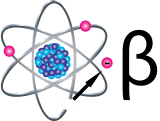Radionuclide Basics: Tritium
 Tritium (abbreviated as 3H) is a hydrogen atom that has two neutrons in the nucleus and one proton. Tritium is produced naturally in the upper atmosphere when cosmic rays strike nitrogen molecules in the air. Tritium is also produced during nuclear weapons explosions, and as a byproduct in nuclear reactors. Although tritium can be a gas, its most common form is in water because radioactive tritium reacts with oxygen to form water.
Tritium (abbreviated as 3H) is a hydrogen atom that has two neutrons in the nucleus and one proton. Tritium is produced naturally in the upper atmosphere when cosmic rays strike nitrogen molecules in the air. Tritium is also produced during nuclear weapons explosions, and as a byproduct in nuclear reactors. Although tritium can be a gas, its most common form is in water because radioactive tritium reacts with oxygen to form water.
Tritium behaves like other forms of hydrogen in the environment. Just as non-radioactive hydrogen reacts with oxygen to create water (H2O), tritium also reacts with oxygen to form “tritiated water” (HTO). As a liquid, tritium moves easily through the environment just like water. Tritium occurs naturally in the environment in very low concentrations.
In the mid-1950s and early 1960s, man-made tritium was widely dispersed during the above-ground testing of nuclear weapons. The quantity of tritium in the atmosphere from weapons testing peaked in 1963 and has been decreasing ever since.
Today, sources of tritium include commercial nuclear reactors and research reactors, and government weapons production plants. Tritium may be released as steam from these facilities or may leak into the underlying soil and ground water.

Tritium can also enter the environment from improper handling, or illegal disposal of exit signs in municipal landfills. As water seeps through landfills, it can spread the tritium from the broken signs. Regulations require that tritium exit signs be returned to a licensed facility for disposal.View online training: “Tritium Exit Signs, Responsible Management.”
Tritium also occurs naturally in the environment in very low concentrations.
Tritium emits a very weak beta particle. People are exposed to small amounts of tritium every day, since it is widely dispersed in the environment and in the food chain. Tritium primarily enters the body when people swallow tritiated water, inhale tritium as a gas in the air, or absorb it through their skin. Once tritium enters the body, it disperses quickly and is uniformly distributed throughout the body. Since tritium is almost always found as water, it goes directly into soft tissues and organs. Tritium is excreted through the urine within a month or so after ingestion. Organically bound tritium (tritium that is incorporated in organic compounds) can remain in the body for a longer period.


